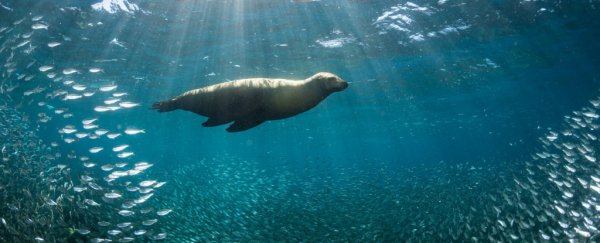We know that global warming is forcing many animals around the world to flee their normal habitats, but now, an exhaustive analysis has shown marine species are booking it for the poles six times faster than those on land.
Drawing together 258 peer-reviewed studies, researchers compared over 30,000 habitat shifts in more than 12,000 species of bacteria, fungi, plants, and animals.
The resulting database, named BioShifts, is the first comprehensive analysis of its kind, and while the database is limited by our own human research biases, the data we have certainly suggests marine species are following global thermal shifts much closer than land animals.
While land species definitely are moving closer to the poles as the planet heats up, this shift is "at a pace that is much slower than expected, especially in areas with warm climates," the authors write.
In the review, amphibians were found to be moving up slope at over 12 metres a year, while reptiles seem to be headed towards the equator at 6.5 metres a year.
Insects, which incidentally carry many diseases, were found to be moving poleward at 18.5 kilometres per year.
Relatively, that's a lot, but in the bigger picture, marine species were moving towards the poles at an average pace of nearly 6 kilometres per year, while land animals were only shifting upslope at a mean pace of nearly 1.8 metres per year (slightly faster than previous estimates for land species, but still comparatively slow).
This discrepancy between land and water could exist for several reasons. It might, for instance, be a product of temperature sensitivity. Air conducts heat 25 times less effectively than water, and many land animals can easily regulate their body temperature if they want.
On the whole, this would logically leave marine species and many ectotherms - cold-blooded species - much more susceptible to Earth's fluctuating temperatures.
Plus, animals in the water can migrate a lot easier if the need arises. On land, human activities often impede the movement of animals. In fact, when animals were exposed to a high degree of anthropogenic disturbances, the authors of this analysis found they tended to move against the thermal grain and not with it.
This is consistent with the general idea that land use and climate change may force species in opposite directions, a sort of push and pull of re-distribution.
"On land, habitat loss and fragmentation due to land use changes may impede the ability of terrestrial species to track shifting isotherms [lines on a map connection regions with the same temperature]," the authors write.
"These complex interactions need to be accounted for to improve scenarios of biodiversity redistribution and its consequences on human well-being under future climate change."
If the authors are right, and marine life is tracking along temperature changes more closely, it could have dire and far-reaching repercussions. Some of which we might have seen before.
During the Permian-Triassic Extinction, the most calamitous event in Earth's history, researchers say very few marine organisms stayed in the same habitat as oxygen levels plummeted.
"It was either flee or perish," according to oceanographer Curtis Deutsch of the University of Washington, and for over 50 percent of marine species at the time, it was unfortunately the latter.
Today, as temperature increases squeeze animals into ever-narrowing habitat ranges, those animals already swimming towards he poles are also at risk of running out of cooler water.
Of course, this is happening on land, too. Animals found high up in the mountains are said to be riding an "escalator to extinction" as temperatures and competition push them over the brink. It's just that in the water this escalator seems to be moving faster.
"We suggest that commercial fishing may speed up the displacement of marine species distribution through resource depletion and population crashes at the trailing edge, whereas low constraints on dispersal in the oceans may allow marine species living close to their upper thermal limits to better track climate warming at the leading edge," the authors predict.
As impressive and necessary as the new database is, however, the authors acknowledge it has serious limits.
Despite its comprehensive nature, the meta-analysis used to create BioShifts only covers 0.6 percent of all known life on Earth, and the animals we have researched tend to be the most charismatic, or important to humans, focused predominantly in the northern hemisphere.
So while we call this a global meta-analysis, it's not really. Instead, it's as close as we can get given the circumstances.
Still, we can only work with what we've got, and it looks like the animals we do know of are struggling to find new habitats in the face of a growing climate crisis.
BioShifts is a way for us to help track those changes so we can possibly predict what will happen next.
The study was published in Nature Ecology & Evolution.
